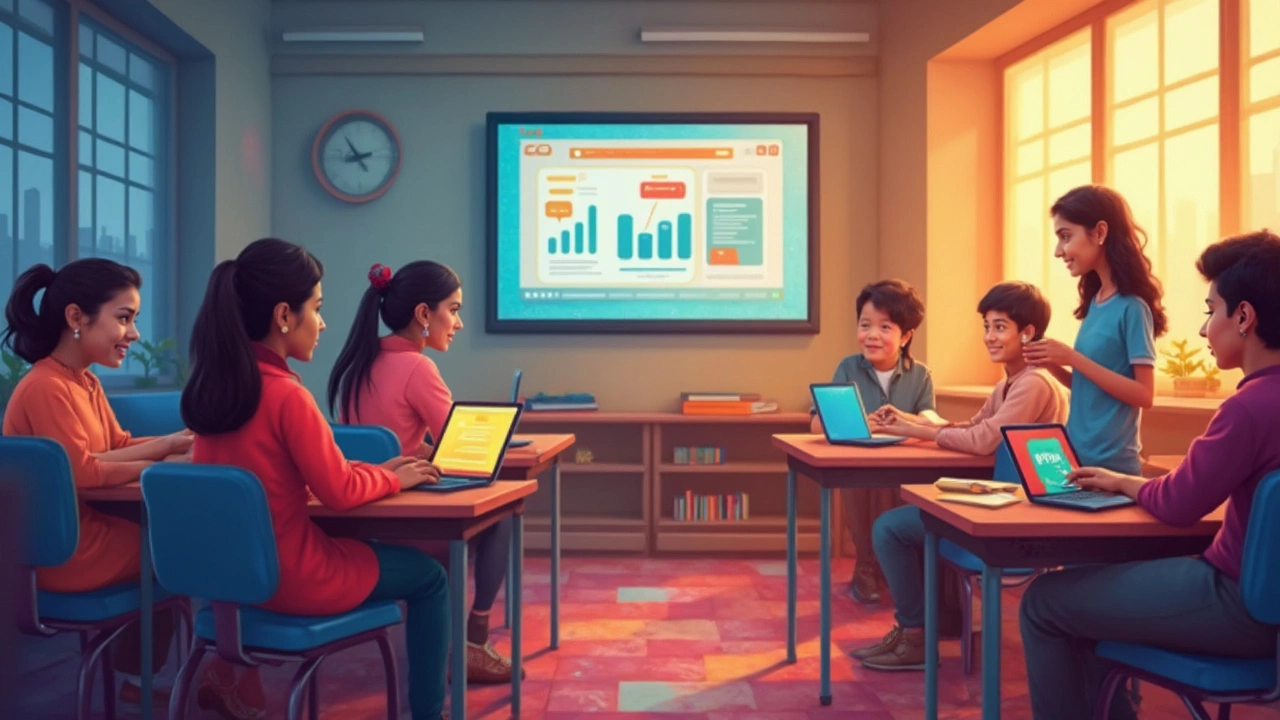
If you’ve ever hunted for an online class, you probably noticed there’s more than one type of e-learning site. Getting lost is easy with all those options and buzzwords flying around. But really, just four main kinds of e-learning platforms dominate the digital world. Knowing these helps you pick smarter—no more guesswork or wasted hours poking around the wrong site.
It’s not just about which platform looks trendy. Each category delivers a different experience. Some are self-paced and wide open, while others offer live classes or let schools manage everything smoothly. Before sinking money or time into a course, it pays to know what sets them apart. Ready to make sense of all the noise? Let’s break down what actually matters when you’re picking your next digital classroom.
- Course Marketplaces: Where Anyone Can Learn
- Learning Management Systems: Organizing Educational Chaos
- Virtual Classrooms: Real-Time Learning, Anywhere
- Mobile Learning Apps: Learning On-the-Go
Course Marketplaces: Where Anyone Can Learn
Course marketplaces put power in the hands of learners. Think of them as huge online stores where anyone can buy (or sometimes even give away) courses—pretty much on any topic you can imagine. Major names like Udemy, Coursera, and Skillshare are pumping out classes every single day. Udemy alone claimed over 64 million users by early 2024, showing just how popular this format has become.
What sets these platforms apart? You’re not tied to any school. Instead, experts and regular folks alike can upload courses, meaning you get a wild mix—everything from Python coding to painting watercolors with a cat on your lap. These courses are often self-paced, so you move at your speed and can dip in whenever life allows. Some even offer certificates, which come in handy if you’re after proof for your boss or LinkedIn.
Here are a few practical things to look for when poking around on a e-learning course marketplace:
- Check real reviews—actual learners spell out what’s good, what’s confusing, and if the instructor sounds like a robot.
- Look for up-to-date content. Tech and business topics change fast; outdated material just wastes your time.
- If you care about certificates, make sure the platform or the instructor actually provides them.
- Compare prices, but also check for sales—Udemy is famous for slashing course prices to just a few bucks during promos.
Want a quick at-a-glance rundown?
| Platform | Users (2024) | Main Strength |
|---|---|---|
| Udemy | 64 million+ | Huge course variety, regular sales |
| Coursera | 129 million+ | University partnerships, professional certificates |
| Skillshare | 12 million+ | Creative skills, project-based learning |
One last tip: Don’t be afraid to test a lesson or two. Many platforms let you sample free videos before you buy the whole thing. That’s how you dodge courses that look cool on paper but just bore you to sleep—or worse, sound like they were recorded in a cave.
Learning Management Systems: Organizing Educational Chaos
Trying to teach or learn online without a plan can turn into pure chaos. That’s where Learning Management Systems—people just call them LMS—step in. These platforms are like digital command centers for education. They let teachers set up courses, give homework, run quizzes, and keep track of everyone’s progress in one spot. If you’ve ever used Moodle, Blackboard, or Canvas, then you know what I’m talking about. Even big companies use them to train employees, not just schools and colleges.
The biggest win? Everything is under control. With an LMS, you don’t have to dig through email chains or worry if students missed a worksheet. These platforms let you upload videos, schedule assignments, give instant feedback, and even host forums for class discussions. Plus, you can check who’s been slacking—or killing it—with just a few clicks.
Here’s a real tidbit for you: the e-learning LMS market is huge. In 2024, researchers said it hit almost $19 billion worldwide. More schools and companies are switching every year because it saves time, tracks student progress automatically, and can even integrate with tools like Zoom or Google Drive.
| LMS Platform | Main User | Notable Feature |
|---|---|---|
| Canvas | Universities | Modern, mobile-friendly interface |
| Moodle | Schools, Corporations | Open-source, highly customizable |
| Blackboard | Colleges | Dynamic grading and analytics |
| TalentLMS | Businesses | Easy employee onboarding |
If you’re considering an LMS, focus on a few basics:
- Is it easy to use without constant tech support?
- Can you access it from any device—laptop, phone, tablet?
- Does it let you track progress and get reports you actually understand?
- Can it grow with you as your class or company gets bigger?
Pick the right LMS, and suddenly all your digital learning feels organized—no more missing files or confusing email chains. Deciding what you need from the start saves future headaches. Even Luna, my cat, could probably follow the instructions if she wanted to—these platforms, when picked well, really make life that simple.

Virtual Classrooms: Real-Time Learning, Anywhere
Virtual classrooms are exactly what they sound like—live, online spaces where teachers and students connect in real time. Think of them like a Zoom meeting, but designed for learning, with features for group discussion, live quizzes, sharing notes, and splitting the class into smaller groups. Popular options include Zoom for Education, Microsoft Teams, and Blackboard Collaborate. These platforms have been game-changers, especially during the pandemic, as they let classes keep rolling even when everyone’s at home.
The big deal with virtual classrooms is real-time interaction. Students can ask questions, work on group projects, and get instant feedback just like in a physical classroom. For language learning, science demos, or test prep, this setup feels a lot more personal and responsive than just watching recorded videos.
- Tools like whiteboards, chat windows, and screen sharing keep everyone on the same page.
- Breakout rooms let teachers split students into small groups for team tasks or brainstorming.
- Polls and quick quizzes help teachers know who’s keeping up and who needs more help.
Numbers don’t lie. By early 2024, over 90% of universities in the US had implemented virtual classrooms for at least some of their courses. Globally, the education technology market, which includes these platforms, passed $340 billion in 2023. That’s huge, and it shows how e-learning isn’t just a pandemic trend—it’s a new standard.
| Platform | Key Features | Used By |
|---|---|---|
| Zoom for Education | Breakout rooms, live polls, recording | Schools, universities, corporate training |
| Microsoft Teams | Chat, file sharing, integration with Office | Schools, businesses, online workshops |
| Blackboard Collaborate | Interactive whiteboard, hand-raising, analytics | Universities, K-12 schools |
Want to get the most from virtual classrooms? Here’s a pro tip: set up your camera and mic before joining to avoid last-minute tech headaches. Another good move—get familiar with the platform’s buttons and features, so you don’t have to hunt around while everyone waits. And, always double-check your Wi-Fi. Even the best teacher can’t help if your video keeps freezing.
Mobile Learning Apps: Learning On-the-Go
Phones are glued to our hands, so it’s no surprise that e-learning has gone mobile too. Whether you’re on a packed train or waiting in line at the coffee shop, mobile learning apps let you squeeze in quick lessons anywhere—no laptop needed. You’ll see language apps like Duolingo, coding platforms like SoloLearn, flashcard tools (think Anki), and skill-based options like Coursera’s app all letting you access lessons in tiny chunks on your schedule.
Convenience is the real beast here. Push notifications keep you on track. A study in 2022 found mobile learners studied 40% more often, even though sessions were shorter. Why? It’s just easier to pick up where you left off, and app designs push you to keep going. Multimedia—quick video explainers, interactive quizzes, and voice chats—makes things stick, not just look pretty.
Plenty of these apps don’t even need you online after download. Offline learning is a lifeline for spotty internet, so a lot of platforms let you save courses or quizzes right to your device. Not sure which features make a difference? Here’s what top-rated mobile learning apps often have:
- Offline access for videos, tests, and notes
- Short, low-pressure practice sessions (great for busy days)
- Customizable reminders and learning streaks
- Easy tracking of your progress with charts or badges
- Community chat or help boards for questions
App stores are flooded with options, so checking download numbers and reviews is smart. And if you need proof that mobile learning is more than a fad, check out these 2024 stats from industry reports:
| App | Active Users (Monthly) | Most Popular Subjects |
|---|---|---|
| Duolingo | 60 million+ | Languages |
| CoursEra | 13 million+ | Business, Tech, Personal Growth |
| Quizlet | 30 million+ | Exam prep, science, languages |
| LinkedIn Learning | 7 million+ | Professional Skills |
So, if you’re the type who wants to use every spare minute—on public transit or during lunch breaks—mobile learning apps make e-learning super flexible. Just be ready: they might turn your casual scrolling into real skills before you realize it.





